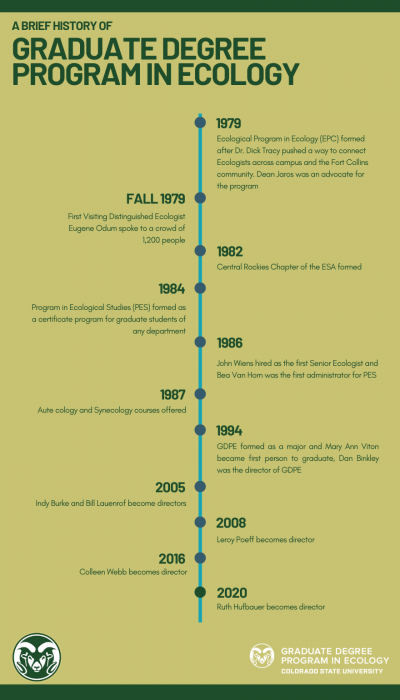GDPE History
History of the Graduate Degree Program in Ecology
1979
Ecological Program in Ecology (EPC) formed after Dr. Dick Tracy pushed a way to connect ecologists across campus and the Fort Collins Community. Dean Jaros was an advocate for the program.
Fall 1979
First Visiting Distinguished Ecologis, Eugene Odum, spoke to an audience of 1,200 people.
1982
Central Rockies Chapter of the ESA Formed
1984
Program in Ecological Studies (PES) formed as a certificate program for graduate students from any department

The Graduate Degree Program in Ecology (GDPE) was the first interdisciplinary program in the history of CSU. It paved the way for five additional interdisciplinary programs that currently exist across campus. However, the formation of GDPE took 20 years and relied upon the persistence and commitment of many faculty, staff and administrators.
Establishing a Program
The idea for GDPE began in the 1970’s with a group of dedicated CSU faculty who advocated for an interdisciplinary, collaborative, and community-oriented ecology program at CSU. Although the work of building an entire graduate degree lay on the shoulders of many, the original idea for an ecology program can be attributed to Dr. Dick Tracy.
When Dr. Tracy arrived in the Zoology Department in 1974, he immediately saw the potential to unite ecologists on the CSU campus and in agencies across Fort Collins. At the same time, he saw that there was no ecology degree program to unite their ecological research. Dick knew that creating a degree program would take time, effort, and a lot of support. With that in mind, Dr. Tracy strategically started his campaign by building recognition of the ecological prowess CSU already had.
In 1977, Dr. Tracy approached ecologists in different departments and colleges, the Dean of the Graduate School, Dr. Dean Jaros, and Academic Vice President, Dr. Chuck Neidt to support his efforts. This led to the formation of the Ecology Program Committee (EPC) in 1979.
To showcase the ecological clout of CSU, the EPC started the Visiting Distinguished Ecologist Series. In fall 1979, a crowd of 1,200 people gathered for the first Distinguished Ecologist (DE): the famous Eugene Odum, a pioneer in the discipline of Ecology. This program continues today, and has hosted outstanding ecologists from around the world.
With support from faculty members, students, and the administration, EPC transitioned into the Program in Ecological Studies (PES) as a part of the Graduate School in 1984. During that time, it was framed as a certificate that could be achieved alongside any graduate degree on campus.
“People wanted to have ‘Ecology’ on their transcript. There were already people all over campus doing ecological research, but this put an official title to that work,” said Dave Steingraeber.
In 1984 as CSU stepped closer to a degree in Ecology, by hosting the Ecological Society of America (ESA) joint conference with the American Institute of the Biological Science, the Botanical Society, and the Assocaiteion for Tropical. Many left the conference speaking highly of ecology at CSU.
With camaraderie and complimentary research goals, the Program in Ecological Studies campaigned for a way for students to earn degrees in Ecology. However, an interdisciplinary degree program had no precedent on the CSU campus. Dr. Steingraber and Dr. John Wiens with broad support including from Dean Jaros, the Graduate Degree Program and Ecology came to fruition.
On July 1st, 1994, days after the formal recognition of the program, Mary Ann Vinton became the first student to defend an Ecology degree at CSU. The first program director was Dan Binkley. Along with the birth of GDPE, the Front Range Student Ecology Symposium (FRSES) began, highlighting all the collaborative work being done in the program, at CSU, and across the larger Front Range community. In the first four years, GDPE blossomed from its first student to enrolling 80 graduate students.
“It has always been the grassroots faculty really putting in the effort. That is one of the joys of it, in all the history of it, is that the people are enthused by it, not that it is dictated from above,” said Dave Steingrabaer.
Modern Day GDPE
GDPE is now more than 25 years old. It has been led by five directors, supported over 500 graduates, and provided over $20,000 annually to its students. However, it will always be remembered as a community of people committed to furthering future generations of ecologists, while having a grand time doing it.
